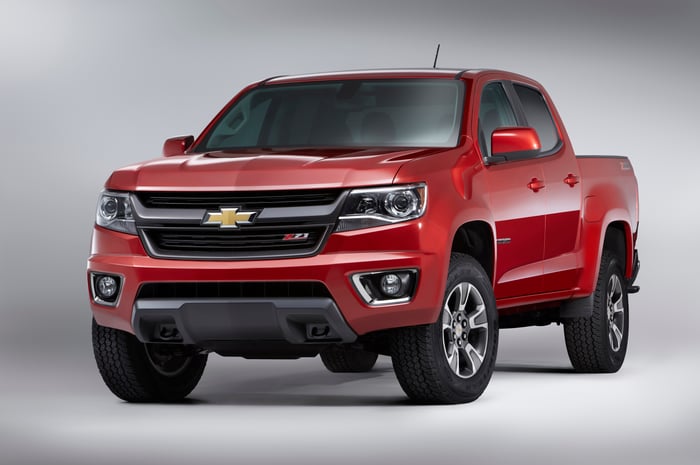Fiat Chrysler (FCAU) shares soared between mid-2016 and early 2018, as investors grew comfortable with the company's turnaround plan. Fiat Chrysler has slashed production of low-margin cars while leaning on its lucrative Jeep and Ram brands for growth. These efforts have succeeded for the most part, as Fiat Chrysler recently reported a record adjusted operating profit (6.7 billion euros) for the fifth consecutive year.
However, having completed its restructuring, Fiat Chrysler is struggling to offset new earnings headwinds and drive further earnings growth. By contrast, General Motors (GM -0.44%) is still in the early stages of a similar strategy shift. As a result, GM is positioned for stronger earnings and cash flow growth over the next two to three years.
GM ends 2018 on a strong note
Last month, General Motors advised investors that adjusted earnings per share exceeded $6.20 -- the high end of its guidance range -- in 2018. Indeed, GM posted adjusted EPS of $1.43 for the fourth quarter, smashing the average analyst estimate and bringing its full-year adjusted EPS to $6.54.
GM's ability to hold earnings roughly flat last year was particularly impressive because the company faced significant cost headwinds from tariffs and rising commodity prices. It also had to cope with production downtime for its lucrative full-size trucks as it transitioned to all-new versions of the Chevy Silverado and GMC Sierra.

GM launched an all-new version of the Chevy Silverado last year. Image source: General Motors.
Looking ahead to 2019, the General expects further earnings growth, powered by strong demand for its new pickup and crossover models. Cost cuts related to ending production of various unprofitable car models will also help, offsetting an expected $1 billion headwind from lower pension income and higher depreciation expense.
GM's free cash flow trend is even more promising. The automaker reported free cash flow of $3.8 billion for 2018, or $4.4 billion excluding an extra pension contribution. Management expects a sizable uptick in free cash flow in 2019. And by 2020, lower capex and a potential increase in dividends from GM Financial could lift free cash flow to double what General Motors generated last year.
Check out the latest GM earnings call transcript.
Fiat Chrysler hits headwinds
While Fiat Chrysler expects modest operating profit growth in 2019, its forecast calls for an adjusted EPS decline of up to 10%. In fact, Fiat Chrysler's recent earnings report revealed that the company's strong 2018 results were achieved partly by overproduction. U.S. dealer inventories spiked to 90 days of supply by year-end, up from 83 days at the end of September -- which was already well above normal levels.
Fiat Chrysler is reducing production in the first half of 2019 to correct this inventory glut. Since the company books revenue and profit when it ships vehicles to dealers, these production cuts will negatively impact the company's results this year.
Furthermore, Fiat Chrysler warned investors last week that industrial free cash flow could fall from 4.4 billion euros last year to as little as 1.5 billion euros in 2019. It blamed higher capex plans and costs related to a diesel emissions settlement in the U.S. for most of the projected decline.
GM is better-positioned for the future
Despite its reduced earnings outlook for 2019, Fiat Chrysler stock remains significantly cheaper than that of General Motors. That said, the valuation gap has closed to a point where investors should prefer GM, due to its superior positioning.
First, General Motors remains far ahead of Fiat Chrysler in the lucrative pickup market. Fiat Chrysler CEO Mike Manley set an ambitious goal last fall of getting Ram into second place in the U.S. truck market. But while U.S. Ram truck deliveries rose 7% to almost 537,000 last year, that still trailed the Chevy Silverado, which ended 2018 with more than 585,000 domestic deliveries. Including the GMC Sierra, GM delivered more than 800,000 full-size pickups in the U.S. last year. It also delivered 168,334 midsize pickups in the domestic market.

GM has a strong midsize pickup franchise, unlike Fiat Chrysler. Image source: General Motors.
Second, GM dominates the full-size SUV market in the U.S., with more than 70% market share. All-new versions of its Chevy Tahoe and Suburban, GMC Yukon, and Cadillac Escalade models should boost sales and profit in that lucrative segment in 2020 and 2021.
Third, GM is one of the largest automakers in China, through its joint ventures with SAIC and Wuling. Fiat Chrysler is a fringe player there, with less than 1% market share. The Chinese auto market has been slumping recently, but it remains quite profitable for GM and a key source of long-term growth for the top U.S. automaker.
General Motors can drive strong earnings and cash flow growth by cutting costs while releasing new and upgraded models in markets where it is already a top player. By contrast, Fiat Chrysler must try to leapfrog GM in a pickup market where customer loyalty is very high, while also gaining share in the ultra-competitive Chinese auto market and turning around its luxury brands. In short, GM has a much easier path to future earnings growth than its smaller rival, making it a better option for long-term investors.





